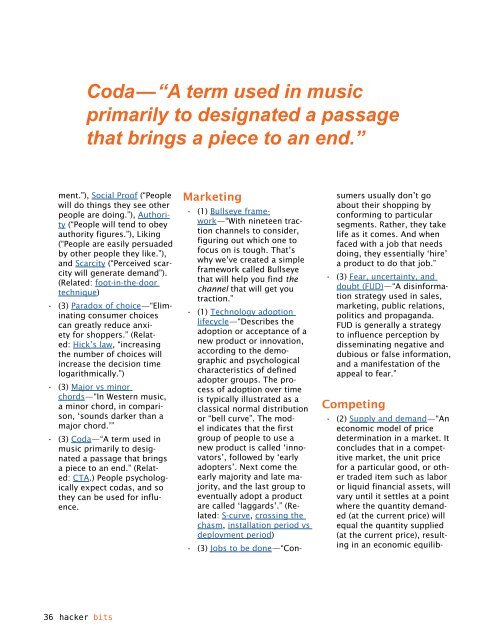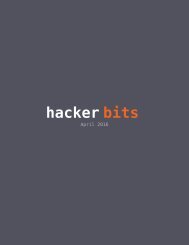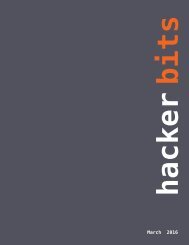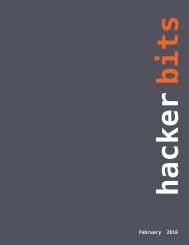Hacker Bits, August 2016
HACKER BITS is the monthly magazine that gives you the hottest technology stories crowdsourced by the readers of Hacker News. We select from the top voted stories and publish them in an easy-to-read magazine format. Get HACKER BITS delivered to your inbox every month! For more, visit https://hackerbits.com/2016-08.
HACKER BITS is the monthly magazine that gives you the hottest technology stories crowdsourced by the readers of Hacker News. We select from the top voted stories and publish them in an easy-to-read magazine format.
Get HACKER BITS delivered to your inbox every month! For more, visit https://hackerbits.com/2016-08.
Create successful ePaper yourself
Turn your PDF publications into a flip-book with our unique Google optimized e-Paper software.
Coda — “A term used in music<br />
primarily to designated a passage<br />
that brings a piece to an end.”<br />
ment.”), Social Proof (“People<br />
will do things they see other<br />
people are doing.”), Authority<br />
(“People will tend to obey<br />
authority figures.”), Liking<br />
(“People are easily persuaded<br />
by other people they like.”),<br />
and Scarcity (“Perceived scarcity<br />
will generate demand”).<br />
(Related: foot-in-the-door<br />
technique)<br />
• (3) Paradox of choice — “Eliminating<br />
consumer choices<br />
can greatly reduce anxiety<br />
for shoppers.” (Related:<br />
Hick’s law, “increasing<br />
the number of choices will<br />
increase the decision time<br />
logarithmically.”)<br />
• (3) Major vs minor<br />
chords — “In Western music,<br />
a minor chord, in comparison,<br />
‘sounds darker than a<br />
major chord.’”<br />
• (3) Coda — “A term used in<br />
music primarily to designated<br />
a passage that brings<br />
a piece to an end.” (Related:<br />
CTA.) People psychologically<br />
expect codas, and so<br />
they can be used for influence.<br />
Marketing<br />
• (1) Bullseye framework<br />
— “With nineteen traction<br />
channels to consider,<br />
figuring out which one to<br />
focus on is tough. That’s<br />
why we’ve created a simple<br />
framework called Bullseye<br />
that will help you find the<br />
channel that will get you<br />
traction.”<br />
• (1) Technology adoption<br />
lifecycle — “Describes the<br />
adoption or acceptance of a<br />
new product or innovation,<br />
according to the demographic<br />
and psychological<br />
characteristics of defined<br />
adopter groups. The process<br />
of adoption over time<br />
is typically illustrated as a<br />
classical normal distribution<br />
or “bell curve”. The model<br />
indicates that the first<br />
group of people to use a<br />
new product is called ‘innovators’,<br />
followed by ‘early<br />
adopters’. Next come the<br />
early majority and late majority,<br />
and the last group to<br />
eventually adopt a product<br />
are called ‘laggards’.” (Related:<br />
S-curve, crossing the<br />
chasm, installation period vs<br />
deployment period)<br />
• (3) Jobs to be done — “Consumers<br />
usually don’t go<br />
about their shopping by<br />
conforming to particular<br />
segments. Rather, they take<br />
life as it comes. And when<br />
faced with a job that needs<br />
doing, they essentially ‘hire’<br />
a product to do that job.”<br />
• (3) Fear, uncertainty, and<br />
doubt (FUD) — “A disinformation<br />
strategy used in sales,<br />
marketing, public relations,<br />
politics and propaganda.<br />
FUD is generally a strategy<br />
to influence perception by<br />
disseminating negative and<br />
dubious or false information,<br />
and a manifestation of the<br />
appeal to fear.”<br />
Competing<br />
• (2) Supply and demand — “An<br />
economic model of price<br />
determination in a market. It<br />
concludes that in a competitive<br />
market, the unit price<br />
for a particular good, or other<br />
traded item such as labor<br />
or liquid financial assets, will<br />
vary until it settles at a point<br />
where the quantity demanded<br />
(at the current price) will<br />
equal the quantity supplied<br />
(at the current price), resulting<br />
in an economic equilib-<br />
36 hacker bits















